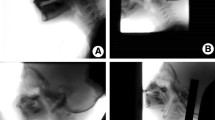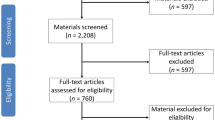Abstract
Modified Barium Swallow Studies (MBSSs) are important tests to aid the diagnosis of swallowing impairment and guide treatment planning. Since MBSSs use ionizing radiation, it is important to understand the radiation exposure associated with the exam. This study reports the average radiation dose in routine clinical MBSSs, to aid the evidence-based decision-making of clinical providers and patients. We examined the MBSSs of 200 consecutive adult patients undergoing clinically indicated exams and used kilovoltage (kV) and Kerma Area Product to calculate the effective dose. While 100% of patients underwent the exam in the lateral projection, 72% were imaged in the upper posterior-anterior (PA) projection and approximately 25% were imaged in the middle and lower PA projection. Average kVs were 63 kV, 77 kV, 78.3 kV, and 94.3 kV, for the lateral, upper, middle, and lower PA projections, respectively. The average effective dose per exam was 0.32 ± 0.23 mSv. These results categorize a typical adult MBSS as a low dose examination. This value serves as a general estimate for adults undergoing MBSSs and can be used to compare other sources of radiation (environmental and medical) to help clinicians and patients assess the risks of conducting an MBSS. The distinction of MBSS as a low dose exam will assuage most clinician’s fears, allowing them to utilize this tool to gather clinically significant information about swallow function. However, as an X-ray exam that uses ionizing radiation, the principles of ALARA and radiation safety must still be applied.




Similar content being viewed by others
References
Martin-Harris B, Logemann JA, McMahon S, Schleicher M, Sandidge J. Clinical utility of the modified barium swallow. Dysphagia. 2000;15:136–41. https://doi.org/10.1007/s004550010015.
Martin-Harris B, Jones B. The videofluorographic swallowing study. Phys Med Rehabil Clin N Am. 2008;19:769–85. https://doi.org/10.1016/j.pmr.2008.06.004.
Martin-Harris B, Brodsky MB, Michel Y, Castell DO, Schleicher M, Sandidge J, Maxwell R, Blair J. MBS measurement tool for swallow impairment—MBSImp: establishing a standard. Dysphagia. 2008;23:392–405. https://doi.org/10.1007/s00455-008-9185-9.
Radiation Protection and Safety of Radiation Sources: International Basic Safety Standards. IAEA Safety standards for protecting people and the environment. Series No. GSR Part 3. Vienna: IAEA; 2014.
Tomà P, Bartoloni A, Salerno S, Granata C, Cannatà V, Magistrelli A, Arthurs OJ. Protecting sensitive patient groups from imaging using ionizing radiation: effects during pregnancy, in fetal life and childhood. Radiol Med. 2019;124:736–44. https://doi.org/10.1007/s11547-019-01034-8.
Bonilha HS, Huda W, Wilmskoetter J, Martin-Harris B, Tipnis SV. Radiation risks to adult patients undergoing modified barium swallow studies. Dysphagia. 2019;34:922–9. https://doi.org/10.1007/s00455-019-09993-w.
Mettler FA Jr., Huda W, Yoshizumi TT, Mahesh M. Effective doses in radiology and diagnostic nuclear medicine: a catalog. Radiology. 2008;248:254–63. https://doi.org/10.1148/radiol.2481071451.
Aldrich JE, Williams J. Change in patient doses from radiological examinations at the Vancouver General Hospital, 1991–2002. Can Assoc Radiol J. 2005;56:94–9.
Hersh C, Wentland C, Sally S, de Stadler M, Hardy S, Fracchia MS, Liu B, Hartnick C. Radiation exposure from videofluoroscopic swallow studies in children with a type 1 laryngeal cleft and pharyngeal dysphagia: a retrospective review. Int J Pediatr Otorhinolaryngol. 2016;89:92–6. https://doi.org/10.1016/j.ijporl.2016.07.032.
Chau KH, Kung CM. Patient dose during videofluoroscopy swallowing studies in a Hong Kong public hospital. Dysphagia. 2009;24:387–90. https://doi.org/10.1007/s00455-009-9214-3.
Yao H, Huda W, Mah E, He W. Review of kerma-area product and total energy incident on patients in radiography, mammography and CT. Radiat Prot Dosimetry. 2015;163:251–60. https://doi.org/10.1093/rpd/ncu157.
Bonilha HS, Wilmskoetter J, Tipnis S, Horn J, Martin-Harris B, Huda W. Relationships between radiation exposure dose, time, and projection in videofluoroscopic swallowing studies. Am J Speech Lang Pathol. 2019;28:1053–9. https://doi.org/10.1044/2019_ajslp-18-0271.
Bonilha HS, Wilmskoetter J, Tipnis SV, Martin-Harris B, Huda W. Effective dose per unit kerma-area product conversion factors in adults undergoing modified barium swallow studies. Radiat Prot Dosimetry. 2017;176:269–77. https://doi.org/10.1093/rpd/ncx006.
Tapiovaara M, Siiskonen T. PCXMC: a Monte Carlo program for calculating patient doses in medical X-ray examination. 2nd ed. Helsinki: Finnish Centre for radiation and nuclear safety; 2008.
Bhattacharyya N. The prevalence of dysphagia among adults in the United States. Otolaryngol Head Neck Surg. 2014;151:765–9. https://doi.org/10.1177/0194599814549156.
Martin CJ. Effective dose: how should it be applied to medical exposures? Br J Radiol. 2007;80:639–47. https://doi.org/10.1259/bjr/25922439.
US Nuclear Regulatory Commission. Doses in our daily lives. 2020. https://www.nrc.gov/about-nrc/radiation/around-us/doses-daily-lives.html. Accessed 18 June 2020
US Nuclear Regulatory Commission. Title 10 part 20 of the code of federal regulations (10 CFR Part 20): standards for protection against radiation. Rockville: US Nuclear Regulatory Commission; 2020.
Miller DL, Vañó E, Bartal G, Balter S, Dixon R, Padovani R, Schueler B, Cardella JF, de Baère T. Occupational radiation protection in interventional radiology: a joint guideline of the cardiovascular and interventional radiology society of Europe and the Society of Interventional Radiology. Cardiovasc Intervent Radiol. 2010;33:230–9. https://doi.org/10.1007/s00270-009-9756-7.
Centers for Disease Control and Prevention. Radiation from air travel. 2015. https://www.cdc.gov/nceh/radiation/air_travel.html. Accessed 18 June 2020
Funding
This work was supported by the National Institute of Diabetes and Digestive and Kidney Diseases Grant R01DK098222 (H. S. B., B. M. H., S. T.) and by the National Institute of Deafness and Communication Disorders Grant 2K24DC012801-0 (B. M. H.)
Author information
Authors and Affiliations
Corresponding author
Additional information
Publisher's Note
Springer Nature remains neutral with regard to jurisdictional claims in published maps and institutional affiliations.
Rights and permissions
About this article
Cite this article
Tipnis, S.V., Huda, W., Wilmskoetter, J. et al. Radiation Effective Doses to Adults Undergoing Modified Barium Swallow Studies. Dysphagia 37, 399–406 (2022). https://doi.org/10.1007/s00455-021-10291-7
Received:
Accepted:
Published:
Issue Date:
DOI: https://doi.org/10.1007/s00455-021-10291-7




